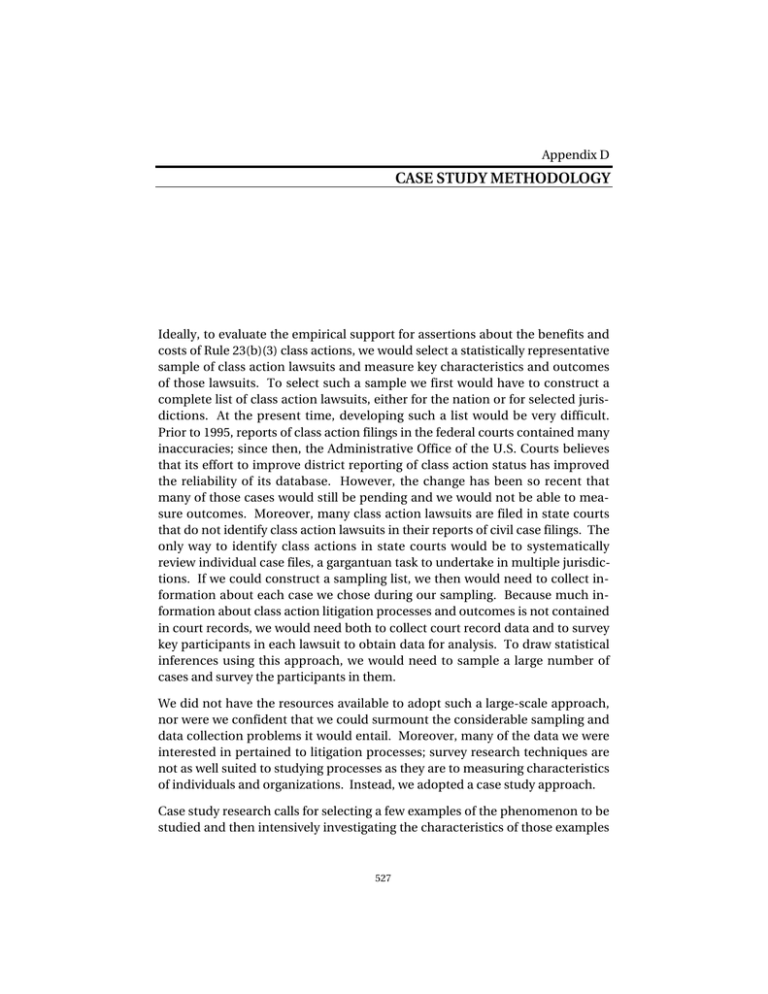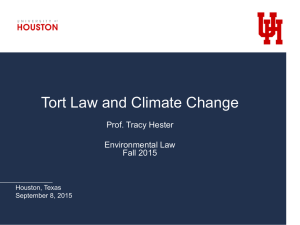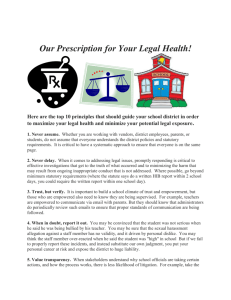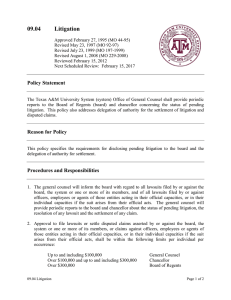Case Study Methodology: Class Action Lawsuits
advertisement

Appendix D CASE STUDY METHODOLOGY Ideally, to evaluate the empirical support for assertions about the benefits and costs of Rule 23(b)(3) class actions, we would select a statistically representative sample of class action lawsuits and measure key characteristics and outcomes of those lawsuits. To select such a sample we first would have to construct a complete list of class action lawsuits, either for the nation or for selected jurisdictions. At the present time, developing such a list would be very difficult. Prior to 1995, reports of class action filings in the federal courts contained many inaccuracies; since then, the Administrative Office of the U.S. Courts believes that its effort to improve district reporting of class action status has improved the reliability of its database. However, the change has been so recent that many of those cases would still be pending and we would not be able to measure outcomes. Moreover, many class action lawsuits are filed in state courts that do not identify class action lawsuits in their reports of civil case filings. The only way to identify class actions in state courts would be to systematically review individual case files, a gargantuan task to undertake in multiple jurisdictions. If we could construct a sampling list, we then would need to collect information about each case we chose during our sampling. Because much information about class action litigation processes and outcomes is not contained in court records, we would need both to collect court record data and to survey key participants in each lawsuit to obtain data for analysis. To draw statistical inferences using this approach, we would need to sample a large number of cases and survey the participants in them. We did not have the resources available to adopt such a large-scale approach, nor were we confident that we could surmount the considerable sampling and data collection problems it would entail. Moreover, many of the data we were interested in pertained to litigation processes; survey research techniques are not as well suited to studying processes as they are to measuring characteristics of individuals and organizations. Instead, we adopted a case study approach. Case study research calls for selecting a few examples of the phenomenon to be studied and then intensively investigating the characteristics of those examples 527 528 Class Action Dilemmas (“cases”). By closely examining a relatively small number of cases, and comparing and contrasting them, the researcher learns about significant features of the phenomenon and how it varies under different circumstances. Case study research is particularly well suited to investigating processes.1 After deciding to adopt a case study approach and considering the data collection that would be required, we determined that we had sufficient resources to study ten class action lawsuits. WHAT TYPES OF CASES DID WE CHOOSE FOR OUR CASE STUDIES? Because we could not hope to reflect the full diversity of class actions with ten cases, we decided that we would focus on two case types that have been the target of most of the criticism leveled at class actions in recent years: consumer class actions involving small individual losses and mass tort class actions involving personal injury and property damage. 2 Within the two categories we selected, we wanted to study a mix of complaints. In the consumer category, we sought examples of complaints about fees, deceptive advertising, and other unfair trade practices. In the mass tort category we initially wanted to select personal injury cases only, but when we found few personal injury mass torts that met all our selection criteria, we broadened our search to include property damage mass torts as well. We eliminated mass disaster cases, such as building and bridge collapses and hotel fires, from consideration because both defendant representatives and plaintiff attorneys whom we interviewed in the earlier phase of our research reported little controversy over the appropriateness of using a class approach in such situations. HOW DID WE CHOOSE OUR CASE STUDIES? The overarching point to note about our case selection process is that the process was not random but it was as impartial as we could make it. Because we wanted to focus our attention on ordinary or typical damage class action lawsuits, we excluded cases that had attracted widespread controversy (such as the asbestos futures class actions) from consideration. As a result, we did not know what had occurred in most of our cases—the meat of the stories and their outcomes, whether they could be held up as good or bad examples of class action practices—at the time we selected them. (The Texas insurance premium double rounding consumer class action and the blood products mass tort case had each attracted attention from legal academics and the legal press. However, we were not familiar with the facts of these cases when we selected them for study.) Case Study Methodology 529 We established four prerequisites for inclusion as a case study: • The case was certified by the court as a class action; this would include cases certified for settlement only. • The case had been filed within the several years prior to our study. • The case had been substantially closed, which we defined as one that the major parties would agree is complete, even if some minor issue is still open. • The case was central to a litigation, rather than ancillary. We required that the cases selected be certified because we wanted to focus on the outcomes of class actions. An important question for further study is what happens to potential class members and defendants when plaintiff class action attorneys are unable to secure class certification. We required that the cases selected had been filed within a few years prior to our study because many of the practitioners we interviewed in the earlier phase of the study believed that class action practice has changed significantly in recent years. We wanted our study to reflect current, rather than earlier, practice. We required that the cases selected be resolved, because we wanted to know the outcomes of class actions; also, we knew the key participants would be reluctant to share information about ongoing litigation. Because much about the dynamics of the litigation can only be conveyed by insiders, and because much of the information we sought is not part of the public record, we needed the cooperation of the key participants. Unlike our general interviews with class action practitioners, we were not able to guarantee confidentiality to the parties because these cases would be identifiable. Lack of confidentiality ended up being more of a stumbling block in defendants’ willingness to share cost data with us than to their (or other parties’) willingness to talk with us at all, although we encountered some parties who did not want to participate in the study. Although we began the study by requiring cooperation from at least some participants on all sides of the litigation, we later relaxed this criterion when some individuals who had earlier agreed to cooperate with the interviewing process withdrew. For those types of cases in which distribution is accomplished relatively quickly (e.g., a typical consumer dispute), we preferred cases in which all settlement monies had been distributed so that we could construct complete accounts of case outcomes and costs. But for those types of cases in which distribution typically occurs over many years (e.g., when class members can come forward over 530 Class Action Dilemmas a lengthy period to claim compensation), we preferred cases that had been filed and resolved relatively recently—but where the settlement funds had not yet been fully distributed—to older litigation in which all funds had been distributed. Finally, we wanted a mix of cases that included both federal and state court cases, nationwide and more limited classes, and a variety of plaintiffs’ law firms and defendants. SOURCES OF INFORMATION Our sources for case selection included the database that we had constructed of class actions identified by LEXIS and national or business press reports in 1995 and 1996 (see Appendix B). We also consulted the docket of the judicial panel on multidistrict litigation, which indicates litigation in which there has been some class action–related activity. We constructed a master list of all the cases mentioned in the several dozen interviews we had conducted in the earlier phase. (Because we promised confidentiality to respondents in that phase, our list did not contain any attribution to the respondents or their firms or corporations; nor did we include any case information that they asked us to keep confidential.) And we asked two insurance companies that had been involved in a number of small damage consumer cases to assist us by assembling a list of all the recent completed class actions in which they had been involved as defendants so that we could choose one at random. Our criteria ended up being surprisingly restrictive. Many putative class actions in our databases were either never certified as such or were not resolved as class actions; many cases mentioned in our interviews were either not recent, not completed, or were “notorious” cases. Trying to get the cooperation of parties we did not know was time-consuming and led us to reject otherwise promising candidates for study. Ultimately, we identified many of the lawsuits we studied by iteratively choosing cases from the sources mentioned above, searching the LEXIS–NEXIS database and perhaps calling identified individuals to determine whether that case met our criteria (finding out that it often did not) and then searching among similar case types, such as toxic exposure or collateral protection insurance, for a case that did meet our criteria. DATA COLLECTION: WHAT SOURCES DID WE USE AND WHAT TYPE OF INFORMATION DID WE SEEK? For each case, we did a background search on LEXIS–NEXIS for any mention about it in the legal press (including published court opinions), the business press, and the general press. We attempted to interview all key participants in the litigation, including class counsel, in-house and outside counsel for lead Case Study Methodology 531 defendants, objectors, judges and special masters, and when relevant, regulators. We did not attempt to contact representative plaintiffs. Where the parties representing a particular side were numerous, such as in the polybutylene pipes case, we selected respondents to maximize the probability that we would obtain diverse views on the litigation. In all, we interviewed about 80 individuals.3 Finally, we gathered public court documents relating to the litigation dynamics of each case. In the text, at the beginning of each case study’s endnotes, we list the sources we drew upon. To guide our data collection, we developed a protocol that we used for both record searches and interviews with participants. Although we needed to understand the main legal issues involved in each suit, our primary focus was on issues pertaining to the class framework. The main categories for which we collected data included: • initiation of the litigation • roles of regulators and other interested parties such as consumer organizations • class definition (including class size) • class representatives • class certification • competing or ancillary actions • notice • settlement negotiations • settlement agreement • opt-outs • fairness hearings • objectors and intervenors • fees and expenses • other costs • final judgments • execution of settlement provisions • final outcomes, including intangible benefits and costs such as changes in practice • practitioners’ perceptions of the process. 532 Class Action Dilemmas ANALYSIS We assigned two researchers to each case, one of whom drafted an initial case study report. The project leader reviewed all of the drafts and prepared lists of queries seeking clarification and additional information for each case study. Answering these queries usually required further discussion and correspondence with participants in the litigation. After several iterations, the preliminary drafts were then circulated to the key participants for review and comment. The review and comment stage generated further telephone interviews and record data collection. In presenting the case studies, the research teams attempted to tell the story of the litigation rather than to assess the practices of the participants or the litigation outcomes. Our goal was to allow readers to draw their own conclusions. Preparation of Chapter Fifteen, which compares and contrasts the ten cases and discusses their implications, led to further queries, discussions with participants in the litigation, and some final refinements of the case study chapters. Unlike the case studies themselves, Chapter Fifteen is interpretive. The tables accompanying Chapter Fifteen connect the analysis with the facts presented in the case studies, rather than offering new facts. This process of sifting, sorting, and interpreting qualitative information, involving multiple iterations and interactions with case participants, is characteristic of case study research. NOTES 1See Robert Yin, Case Study Research: Design and Methods, 2nd ed. (Thousand Oaks, Calif.: Sage Publications, 1994). 2 We excluded securities fraud cases, which have also been a subject of controversy, from consideration because we could not identify any class action lawsuits that had been completed since the passage of the Private Securities Reform Act of 1995, and we felt that cases completed prior to this legislation would no longer be useful examples to study. 3 These included a few people whom we had already interviewed in the previous phase of data collection, but who were selected in this phase because they played a key role in one or more of the cases we selected for analysis.



